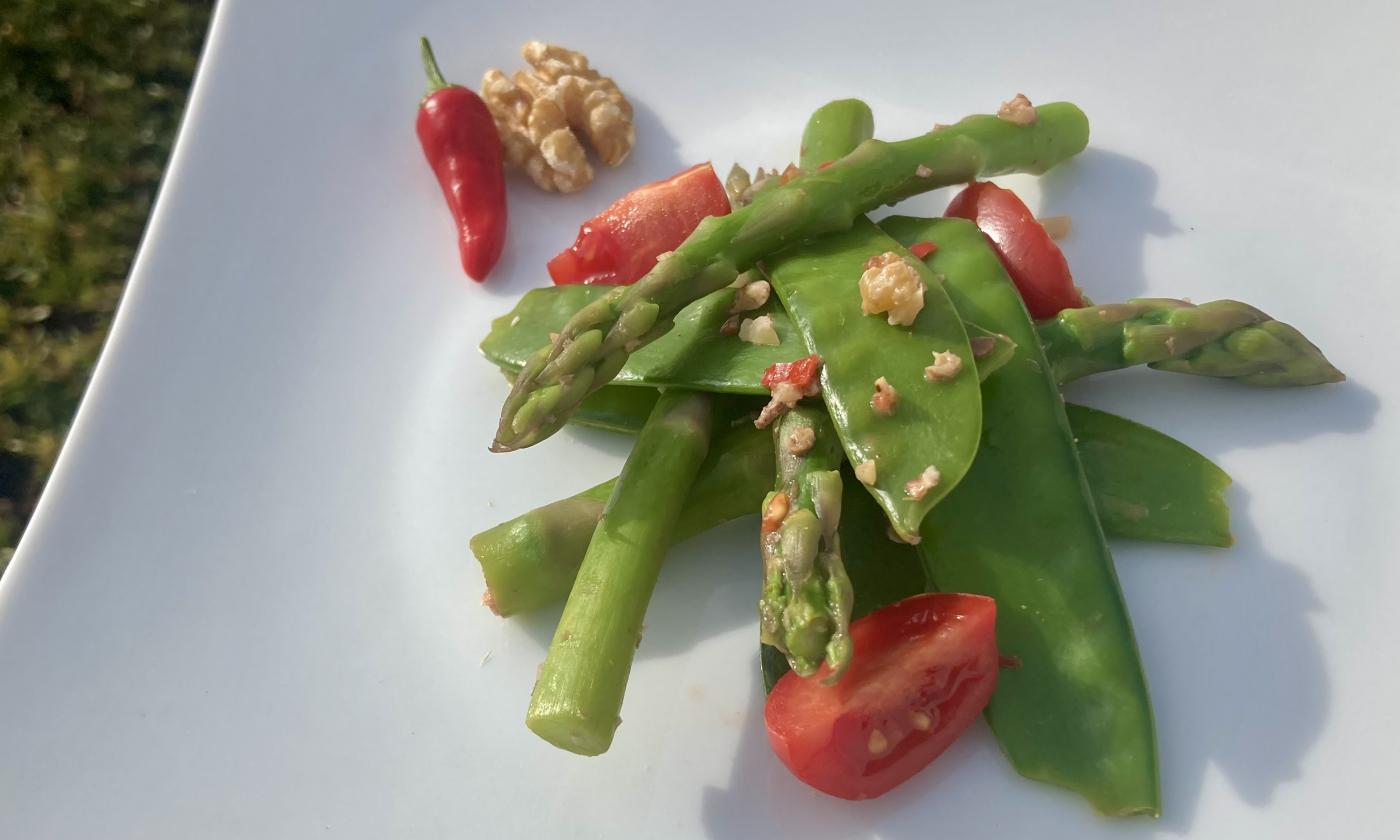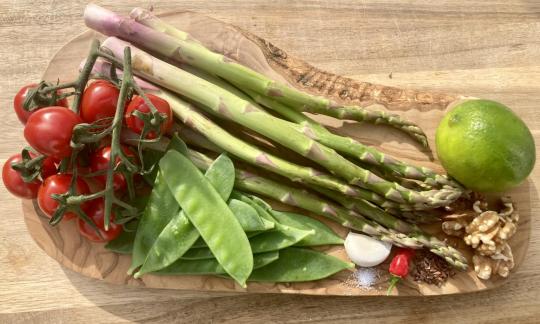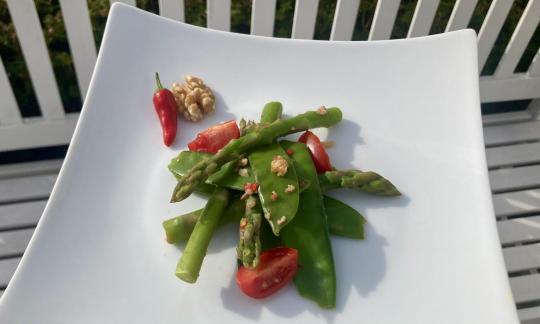Steamed vegetables of green asparagus and sugar snap peas
vegan
Ingredients (for servings, )
| 12 oz | Asparagus, raw (organic?) |
| 7 ⅓ oz | Sugar snap peas, edible pods, raw (organic?) |
| 2 cloves | Garlic (organic?) (0.21 oz) |
| 1 | Chili peppers, red, raw (organic?) (0.18 oz) |
| 2 tbsp | Lime juice (raw?, organic?) (0.51 oz) |
| 1 ¾ oz | Walnuts (tree nuts), raw (organic?) |
| 1 tbsp, ground | Linseed, raw, organic? (golden linseed, flax) (0.25 oz) |
| 5 ½ oz | Cherry tomatoes, raw (cherry tomatoes, organic?) |
| 4 tbsp | Drinking water, raw (organic?) (0.81 oz) |
| 1 dash | Table salt (table salt, raw?, organic?) (0.01 oz) |
Equipment
- steamer basket
- vegetable peeler
- skillet (frying pan)
- stove
- coffee grinder, electric
- citrus juicer (lemon squeezer)
- saucepan
Type of preparation
- cook
- chop or grind
- steam
- squeeze
- sweat
- season to taste
- remove the skin
- peel
Preparation
Preparing vegetables
Wash the green asparagus, peel the thicker ends and cut off the last piece (depending on how woody it is). Cut the asparagus into 3-4 pieces. Clean the sugar snap peas and cut off the ends. Place in a pot with a steamer and steam for about 8 minutes from the time the water boils.
The vegetables should still be noticeably firm.In the meantime, proceed with the next steps.
Note: Purple and especially green asparagus contain more vitamins and healthy secondary plant substances than white asparagus.
Peel and finely chop the garlic. Finely chop the chili. Squeeze the lime juice. Roughly chop the walnuts. Grind the linseed in a coffee grinder. Wash the cherry tomatoes and cut into quarters.
In a pan, sauté the chili and garlic with about 4 tablespoons of water for 4 portions at a medium temperature. As soon as the water has evaporated, remove from the heat, add the tomatoes and walnuts and stir. Mix in the lime juice and linseed as well.If you like it spicy, you can also use 2 chilis for 4 servings.
Completing the dish
Mix the steamed vegetables (from step 1) with the remaining ingredients (from step 2). Season with salt and serve as a side dish with whole wheat pasta or quinoa, for example.
|
Nutritional Information per person
Convert per 100g
|
2000 kcal | |
|---|---|---|
| Energy | 140 kcal | 7.0% |
| Fat/Lipids | 9.2 g | 13.1% |
| Saturated Fats | 0.90 g | 4.5% |
| Carbohydrates (inc.dietary fiber) | 12 g | 4.4% |
| Sugars | 5.1 g | 5.7% |
| Fiber | 5.0 g | 19.9% |
| Protein/Albumin | 6.0 g | 12.0% |
| Cooking Salt (Na:45.8 mg) | 116 mg | 4.9% |
| Essential micronutrients with the highest proportions | per person | 2000 kcal | |
|---|---|---|---|
| Fat | Alpha-Linolenic acid; ALA; 18:3 omega-3 | 1.6 g | 78.0% |
| Vit | Vitamin K | 52 µg | 70.0% |
| Vit | Vitamin C (ascorbic acid) | 44 mg | 54.0% |
| Fat | Linoleic acid; LA; 18:2 omega-6 | 5.0 g | 50.0% |
| Min | Copper, Cu | 0.45 mg | 45.0% |
| Vit | Vitamin B9, B11 (Folate, as the active form of folic acid) | 87 µg | 43.0% |
| Min | Manganese, Mn | 0.80 mg | 40.0% |
| Prot | Tryptophan (Trp, W) | 0.07 g | 27.0% |
| Vit | Vitamin B1 (Thiamine) | 0.29 mg | 26.0% |
| Min | Iron, Fe | 3.5 mg | 25.0% |
Detailed Nutritional Information per Person for this Recipe
The majority of the nutritional information comes from the USDA (US Department of Agriculture). This means that the information for natural products is often incomplete or only given within broader categories, whereas in most cases products made from these have more complete information displayed.
If we take flaxseed, for example, the important essential amino acid ALA (omega-3) is only included in an overarching category whereas for flaxseed oil ALA is listed specifically. In time, we will be able to change this, but it will require a lot of work. An “i” appears behind ingredients that have been adjusted and an explanation appears when you hover over this symbol.
For Erb Muesli, the original calculations resulted in 48 % of the daily requirement of ALA — but with the correction, we see that the muesli actually covers >100 % of the necessary recommendation for the omega-3 fatty acid ALA. Our goal is to eventually be able to compare the nutritional value of our recipes with those that are used in conventional western lifestyles.
| Essential fatty acids | per person | 2000 kcal |
|---|---|---|
| Alpha-Linolenic acid; ALA; 18:3 omega-3 | 1.6 g | 78.0% |
| Linoleic acid; LA; 18:2 omega-6 | 5.0 g | 50.0% |
| Essential amino acids | per person | 2000 kcal |
|---|---|---|
| Tryptophan (Trp, W) | 0.07 g | 27.0% |
| Threonine (Thr, T, irreversibly transaminated) | 0.22 g | 24.0% |
| Valin (Val, V) | 0.36 g | 23.0% |
| Isoleucine (Ile, I) | 0.25 g | 20.0% |
| Leucine (Leu, L) | 0.41 g | 17.0% |
| Lysine (Lys, K, irreversibly transaminated) | 0.28 g | 15.0% |
| Phenylalanine (Phe, F) | 0.23 g | 15.0% |
| Methionine (Met, M) | 0.07 g | 8.0% |
| Vitamins | per person | 2000 kcal |
|---|---|---|
| Vitamin K | 52 µg | 70.0% |
| Vitamin C (ascorbic acid) | 44 mg | 54.0% |
| Vitamin B9, B11 (Folate, as the active form of folic acid) | 87 µg | 43.0% |
| Vitamin B1 (Thiamine) | 0.29 mg | 26.0% |
| Vitamin B6 (pyridoxine) | 0.29 mg | 21.0% |
| Vitamin B2 (Riboflavin) | 0.20 mg | 14.0% |
| Vitamin B5 (Pantothenic acid) | 0.75 mg | 13.0% |
| Vitamin B7 (Biotin, ex vitamin H) | 6.5 µg | 13.0% |
| Vitamin E, as a-TEs | 1.5 mg | 12.0% |
| Vitamin B3 (Niacin) | 1.6 mg | 10.0% |
| Vitamin A, as RAE | 77 µg | 10.0% |
| Essential macroelements (macronutrients) | per person | 2000 kcal |
|---|---|---|
| Potassium, K | 449 mg | 22.0% |
| Phosphorus, P | 139 mg | 20.0% |
| Magnesium, Mg | 56 mg | 15.0% |
| Calcium, Ca | 67 mg | 8.0% |
| Sodium, Na | 46 mg | 6.0% |
| Essential trace elements (micronutrients) | per person | 2000 kcal |
|---|---|---|
| Copper, Cu | 0.45 mg | 45.0% |
| Manganese, Mn | 0.80 mg | 40.0% |
| Iron, Fe | 3.5 mg | 25.0% |
| Zinc, Zn | 1.2 mg | 12.0% |
| Selenium, Se | 3.6 µg | 7.0% |
| Iod, I (Jod, J) | 6.6 µg | 4.0% |
| Fluorine, F | 5.7 µg | < 0.1% |
The steamed, oil-free vegetables of green asparagus and sugar snap peas with lime juice and walnuts are easy to make.
Portion information: The quantity for 4 portions is designed as a side dish for 4 people.
Nutrient profile: According to GDA guidelines, one portion of this recipe covers just over ¾ of the average daily requirement of omega-3 fatty acids. Vitamin K, which plays an important role in blood clotting and bone metabolism, is covered by 70%. In addition, this dish contains a good ratio of omega-6 to omega-3 fatty acids at 3:1 and thus complies with the recommended maximum ratio of 5:1.
Read more at: Vegans often eat unhealthily. Avoidable nutritional errors.
Asparagus: In addition to the white asparagus, which is preferred in the DA-CH countries, there are also violet and green asparagus, which have a more intense flavor. The color of the asparagus is determined by the time of harvest: while white asparagus grows in mounds of earth under the ground, protected from the sun, violet asparagus is harvested as soon as it has broken through the surface of the earth. Green asparagus grows largely above ground. Violet and especially green asparagus contain more vitamins and healthy secondary plant substances than white asparagus. Among other things, asparagus contains the protein building block asparagine, which gave it its name. L-aspartic acid is responsible for its dehydrating effect, promotes kidney function and stimulates water excretion. This is why asparagus is used in traditional medicine to treat bladder infections.
Sugar snap peas (sweet peas): Sugar snap peas are a type of pea from the legume family. The tender sugar snap peas are usually eaten with their pods. They taste similar to peas, but are a little sweeter and juicier. They can be eaten not only cooked, but also raw, for example in a salad. Like peas in general, they do not contain phasin (unlike other legumes), which causes damage to blood cells and the intestinal wall when eaten raw in large quantities. Some pods have threads that must be removed before use. To do this, simply cut off the ends of the pod and pull off the threads. Since fresh pods do not keep for long, they should be eaten quickly.
Cherry tomatoes: Cherry tomatoes are smaller, crisper and sweeter than regular tomatoes. Cherry tomatoes can be red, green, yellow or black.
Walnut: The real walnut, also called tree nut, has the highest content of alpha-linolenic acid (an omega-3 fatty acid that is healthy for the heart) of all nuts. It is also rich in vitamin E, zinc (an important trace element, for the liver and hair, among other things) and potassium (for the heart muscle, among other things).
Asparagus season: The local asparagus season lasts from mid-April to traditionally June 24th. As an imported product, you can now get green asparagus all year round.
Flaxseed: Flaxseed has a slightly nutty taste and is 40% fat. With around 50% of the polyunsaturated omega-3 fatty acid alpha-linolenic acid (ALA), the oil has the highest concentration of omega-3 fatty acids of all known vegetable oils. That is why we added ground flaxseed to this dish.
Steaming: The gentlest way to prepare vegetables is steaming (around 100 °C). Here you cook the vegetables in a pot with a sieve insert in hot steam. Since there is no direct contact with the water, most of the vitamins and nutrients are retained.
If you don't want to do without oil completely, you can use refined rapeseed oil for sautéing in the second step of the recipe.








